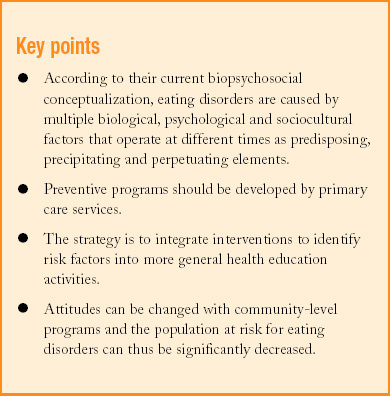Those of us who work with adolescents in primary care know that eating disorders(ED) often begin with innocuous dietary habits that are no different from those of many other adolescents. In addition, we often find that the families of these teenagers--like the families of other teenagers--have problems dealing with conflict and are overly protective and intrusive. This limits privacy and interferes with both the parents' and their children's desire for autonomy. Many patients with anorexia nerviosa are immature, excessively dependent and socially isolated.
The fact that anorexia nerviosa often appears during puberty led psychoanalysts to define it as a developmental problem of identity, and to consider it a defense against emerging adult sexuality. Behavioral psychology professionals have conceived the disorder as an avoidance response to food and the adult body, induced by sexual conflicts and an impaired ability to cope with adult responsibilities. Cognitive psychologists suggest that irrational beliefs and cognitive distortions are the reasons behind these patients' behavioral alterations, and have noted that anxiety is the main factor in the development of bulimia.
For many researchers, ED are linked to a specific sociocultural context whose essential conflicts and generalized psychological tensions become so acute that they generate a high level of anxiety and mobilize psychological defenses--factors that trigger the development of an eating disorder. The symptoms are magnifications of behaviors and attitudes that are normal in such a context. Moreover, some behaviors and attitudes, such as the desire to lose weight, are highly valued socioculturally.
According to their current biopsychosocial conceptualization, eating disorders are caused by multiple biological, psychological and sociocultural factors that operate at different times as predisposing, precipitating and perpetuating elements. A study at the Nursing Research Unit of the Virgen del Rocío University Hospital in Seville (Southern Spain) and published in this issue of Atención Primaria seeks to identify some of the risk factors in a population of adolescents aged 12 to 15 years in their first and second year of secondary school, and in their parents. The study was descriptive and cross-sectional in design, and therefore should be considered a prevalence study. Prospective studies will be needed to estimate the incidence, and although such studies are more expensive, they are more valuable in terms of the epidemiological date they yield--see, for example, the study by researchers at the University of Navarra.1,2
The Seville study was carried out in a single stage with questionnaires. Two-stage studies, with structured, diagnostic interviews in addition to questionnaires, are better in methodological terms.
A number of Spanish studies3 have been published for the population of adolescents aged 12 years or more. Notable among the one-stage studies are that of Toro et al in Barcelona4 and that of Ruiz-Lázaro et al in Teruel.5 Cross-sectional, two-stage studies of note include those by Ruiz-Lázaro et al in Zaragoza,6 Pérez-Gáspar et al in Navarra,7 and Rojo-Moreno et al in Valencia.8 However, there is a need for more prospective studies1,2 that examine the effects of exposure to risk factors in the population of children younger than 12 years old.
The usefulness of cross-sectional studies such as the one carried out in Seville lies in the early detection of a population in which risk factors are present. This makes preventive intervention possible--a measure that can be implemented mainly, but not exclusively, in the classroom.
Preventive programs need to be developed by primary care services. A complete primary prevention program should include, initially, consciousness-raising and information for persons at risk and their families, and for the general public. It should also aim to modify precursors of the illness (such as dieting for no justifiable reason), identify risk groups, and work to develop critical attitudes toward cultural stereotypes and commercial pressures that foment preoccupation with body image. Some of the goals of such programs for children and adolescents should be to favor self-esteem, a nonperfectionist self-image, the ability to enjoy life, interpersonal communication skills, social integration, and a critical attitude toward cultural models and messages from the mass media. Goals for interventions aimed at the family should include reducing overprotection, enhancing communication, affectivity-sexuality and values, and restricting exposure to mass media (particularly television). In addition, these programs should aim to train education professionals so they can identify risk factors.
The strategy is to integrate interventions to identify risk factors into more general health education activities. Specific illness-centered activities should be avoided in order to forestall the copy-cat behaviors these interventions can trigger.
My personal experience as coordinator of programs to promote mental health and community participation for adolescents, parents, educators and social and health professionals8-10 has convinced that it is important not to separate prevention of eating disorders from other health education activities related with food and nutrition, mental and emotional health, affectivity-sexuality, and personal and social development. A global view of prevention is important for programs aimed at adolescents.
A pioneering example of a practical experience with a controlled experimental study in Spain is the ZARIMA-Prevention study. This project found that attitudes can be modified with a community-level program: the population at risk for eating disorders was significantly decreased in the group of adolescents who participated in a community-level intervention.11









